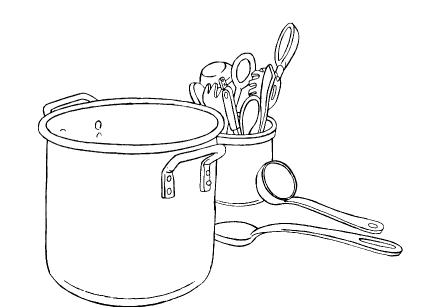
| Contents | Start | Previous | Next |
In general, the equipment you will need includes:
- 2 or 3 very large pots
- 2 or 3 large cast-iron skillets (or woks)
- Several large bowls for mixing and serving
- Large kitchen spoons and ladles
- 2 or 3 large vegetable knives for chopping
- Several cutting boards
- Several plastic containers with lids for the storage, transportation, and serving of food
- 1 bread box with lid and attached pair of tongs for self-service
- 1 coffee urn with spout for serving liquids
- 1 large ice chest for keeping perishables cold on hot days
- 1 propane stove
- 1 or 2 portable tables
- 1 Food Not Bombs banner
- Personal eating utensils (plates, bowls, cups, spoons, forks, and napkins).
This last item involves an ongoing debate around environmental appropriateness.
New groups will usually start off using paper plates, foam cups, and plastic
spoons and forks. However, there is a good deal of concern about the waste
involved in this method. Using paper products made from post-consumer waste
paper, avoiding styrofoam, collecting used plasticware for recycling, and
encouraging people to reuse their cups, plates, and plasticware address
some of the concerns around excessive waste and the consume-and-throwaway
mentality. At some events, it is possible to request that people bring
their own plate, cup, utensils, and cloth napkin. Some Food Not Bombs groups
collect large numbers of durable plastic plates, bowls, and metal flatware
from flea markets and yard sales at very low prices, cheap enough that
if you lose a few at each event it is not much of an economic loss. However,
these items will need to be washed after each meal in a sanitary way, which
is additional work. While there is no perfect solution to feeding large
numbers of people without creating paper and plastic waste, whatever you
can do to cut down on the volume is an opportunity to educate the public
about the need to reduce, reuse, and recycle.
Portable tables are another story. Folding tables you can buy at the
hardware store usually are not sturdy enough to hold large quantities of
food. A very portable table that is sturdy consists of a plain, hollow-core,
interior door (without the doorknob) and a pair of sawhorses made from
metal joiners and 2 x 4's. The door as well as the material for the sawhorses
can be bought at a hardware store or lumber shop for under fifteen dollars.
The hollow-core door is very light, and the joiners allow the sawhorse
legs to be easily assembled and disassembled, also allowing easy transportation.
The recipes you use can be from this book, another cookbook, or a family tradition, or made up experimentally on the spot. In general, strive to make food that tastes as good as you can. It is just as important to respect the dignity of the people we serve as it is to give them nutrition.

Cooking for 100 people is generally not much different than cooking
for ten, except that the quantities are ten times greater. However, for
a few things this is not true. Spices and salt in particular should not
just be multiplied when increasing the quantity of a recipe. Much less
is needed in most dishes, so let your taste-buds be your guide.
| Contents | Start | Previous | Next |